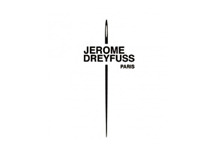Jerome Dreyfuss
Bags
Jérôme Dreyfuss first came to prominence in the fashion world at a young age: he was just 23 years old in 1998 when he unveiled his first collection of “Couture À Porter” – Couture to wear. The bol...
Jérôme Dreyfuss first came to prominence in the fashion world at a young age: he was just 23 years old in 1998 when he unveiled his first collection of “Couture À Porter” – Couture to wear. The boldness, quirky elegance and humor that characterize him were present form the outset and made him into what the media call “The enfant terrible of French fashion”. Until 2002, Jérôme Dreyfuss imagination was focused on clothing, and his creations won plaudits from outside of France. In 2002, after 4 years of effervescence, Jérôme Dreyfuss wanted to start another creative relationship, this time with Accessories. He produced a bag collection called “Roots de Luxe” and over the season has made a trademark of his soft bags, in reptile skins or supple leather, characterized by generous volumes and details that are as exclusive as they are clever. New essential items created by craftsmen chosen for the quality of their expertise and know-how. As women became more and more concerned with environmental issues, Jérôme Dreyfuss introduced his genius idea in 2006. He released his label “Agricouture “, which was a line that was ecologically friendly and helped the environment. French mark Jérôme Dreyfuss soon became known overseas, After its native Paris, the brand stormed the scenes of New York, Hong Kong and Tokyo.Brand Details
Founder
Jérôme Dreyfuss
Designer
Jérôme Dreyfuss
from
1998to
currentBrand Strategy
Market segment
Premium
Core business
Bags
Targets
Men, Women
Jerome Dreyfuss Financial Report 2024
Last fiscal year ended on February 28, 2012

